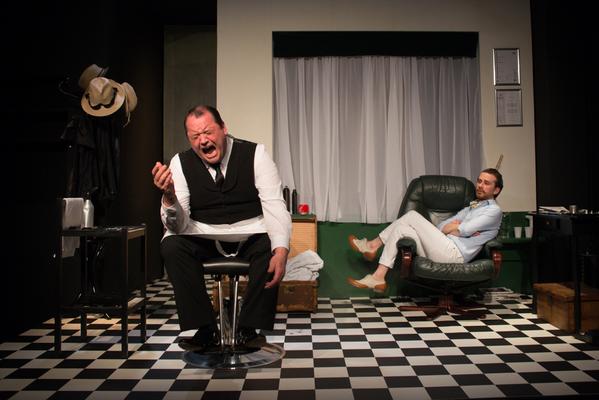
This second course in Kate Wasserberg’s ‘Life in Close Up’ season at Porter’s was a little hard to swallow, especially after the resounding success of the previous production: Sarah Kane’s unforgettable play, Blasted. Kane is a hard act to follow. We all know that. But Howard Barker offers enough explosive action and quasi-philosophical drama to keep us intellectually stimulated in this seventy-minute two-hander, The Dying of Today.
Based rather obscurely on an apparently hot-blooded moment in ancient history – Thucydides’s account of the destruction of the Sicilian expedition in 413BC (don’t ask me) – Barker propounds his ‘theatre of catastrophe’ theory by showing an outbreak of crippling grief within the innocuous surroundings of a barbershop. Dneister, a sprightly customer, notifies the barber, after a flurry of ostentatious yammering, of some bad news: the barber’s son has died. What follows is the gripping breakdown and eventual transformation of the barber’s spirit. Alongside that, some thought-provoking conclusions are reached through the men’s incessant and progressively violent interaction about the nature of belief, war and death.
The problem, in my opinion, is the writing. Barker is quoted in the programme as having said that he ‘[doesn’t] think about the audience at all’ when writing. Then who is he writing for? Clearly himself. His convoluted style of dramaturgy comprises complex, meandering sentences that attempt to clarify such themes as war and belief. This, to me, leaves no room for characterisation and renders both these characters as the exact same person. The result is self-indulgent. If we take Sarah Kane’s writing (which, for me, is far superior to Barker’s), we can see how she can create fully-formed scenes and characters while still tackling big themes but distilling down to the simplest, clearest image or essence, making truly engaging drama. She can make a catastrophe clear of clouds. You may call me a philistine for badgering Barker but I think his style was unnecessarily decadent, placing style high over substance.
Saying that, a pair of riveting performances are still on offer, brought to fruition by Kate Wasserberg’s always brilliant, scrupulous direction. Leander Deeny, as the visitor burdened with bad news, blabbers to the barber with striking volatility, injecting some valued humour into tense moments. Christian Patterson excels once again as an initially reserved character before exploding into a range of fluctuating emotions. His acting is truly a pleasure to watch. I’d happily go along to any play with Patterson in the cast. The final sequence, however, of the barber reflecting on what has happened to the tune of ‘People They Ain’t No Good’ reeks of the toe-curling sentimentality of an X Factor sob story. It simply does not correlate with the play’s deeply serious and unsentimental subject matter.
Wasserberg’s second offering in this season then may not be as strong as Blasted, but there still is enough enrapturing action to keep anyone engaged.
‘The Dying of Today’ is at The Other Room in Porter’s, Cardiff until 11th April 2015
Photography by Pallasca Photography
Category Archives: Theatre
Review The Nether, Duke of York by Hannah Goslin

Critically acclaimed, The Nether was a show I was very eager to watch. I did not immediately decide to find the story line out, as I feel this somewhat limits the surprise at times. However, seeing advertising media about this production, it was safe to assume that it was a futuristic or technological based world from the sci-fi aesthetic.
The story is about a progression that could be argued as possible in our own future, where the internet or ‘The Nether’ is predominant. Virtual reality is very much a common realistic event. Here we see a detective, investigating the known ‘Papa’ who has created a world unlike before; with the ability to trigger the senses and make it all seem very real. The gruesome part of this is that this world lets users undertake paedophilic fantasies and yet, still be able to feel the act itself.
The set was phenomenal – a large screen took the background where video images, sound recording and so on was mixed in a collage. This rose after a computer graphic-ed outline of the virtual reality world was formed and then appeared on stage in a higher imbedded area. Papa had made this world-old fashioned – Victorian styled yet there was always a sense of this being a different world and technology fuelled.
The narrative itself is a hard one to sit through. Yet, the theatricality of it is fantastic, giving a sense of fear and uneasiness with its’ content and how likely this future could be. The actors are all brilliant. Their skills and dominance of the stage is overwhelming and also admiring to their ability to take on such a story. There was the ability to be emotional and to hit us with this, but also naturalism; the characters could have been as real as the person walking by you in the street, which, for a production about virtual reality and a future world, it would seem strange to be so natural in.
Overall, I enjoyed this taboo busting production. In the middle of a section of theatre land where you would expect to see mostly musicals and popular plays, something that really contrasts to this is a breath of fresh air. You come away in awe but also with a sense that you should not have enjoyed it due to the content, but you cannot help but admire the guts to put on such a hard hitting production. And surely, this is an area of theatre that should be more prominent in the West End.
Review The Dying of Today The Other Room by Kaitlin Wray
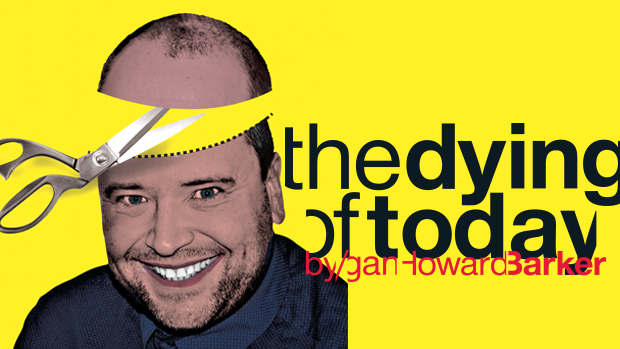
The Other Room opens its second production in its ‘Life in Close Up’ season at Porters pub Cardiff. After the success of ‘Blasted’ by Sarah Kane a few weeks earlier, ‘The Dying of Today’ by Howard Barker was a perfect follow up for this season of plays.
Set in a 1960’s Barbers shop with only two actors. It was a great reenactment of Howard Barker’s work showcasing his creativity and his poet-like writing. The music, playing at the beginning, contextualised this scene and brought us straight into the barbers room while he was cutting the travellers hair. It’s exciting when you see a play that can change your mind and educate you into a whole new wavelength of conversations and the beauty at hearing ‘bad news’ can have. The traveller in this play is excited at the prospect of giving bad news, his excuse, “I think men are more beautiful flung down than standing up”. This line of thought caught my attention completely and made this play conform to the ‘Life in Close Up’ season theme.
Directed by Kate Wasserberg, she knew just how to present Barker’s work for the Other Room’s Theatre stage. The originality in some of the directing choices was inspiring. The symbolism of a small pawn chess piece representing the barbers son drew the audience into the story even more. Every time the Barber picked up the chess piece we knew instantly what he was thinking and found ourselves believing that one small chess piece was his son at war. Moreover Kate expanded the relationship between two strangers into something beautiful. When the Barber puts on his shoes for the lonely traveller towards the end of the show it was heartbreaking. Personally it felt like the Barber was adopting the traveller like his son. In the space of their hours conversation, meeting for the first time, those two characters shared something so big that they would forever have a connection, (good or bad) and thats due to the bringing of bad news.
Leander Deeny, showcases the traveller that is visibly excited at the prospect of giving bad news. Leander was engaging from the beginning and with his elevated mannerisms he created a strong character. For the first five minutes he solely takes the stage speaking of bad news while the Barber just listens. There wasn’t one moment when I felt my mind wander when he spoke, he completely had the audience in the palm of the hand. Christian Patterson, playing the Barber, takes The Other Room’s stage a second time after his success of playing the grotesque and corrupt character of Ian in Sarah Kane’s ‘Blasted’. Christian’s mannerisms at the start of ‘The Dying of Today’ were subtly engaging. As he was hearing the news from the traveller his facial expression grew more and more troubled until after not speaking for the first 5 minutes he speaks. Christians emotions goes through a whole roller coaster engaging us into his mind and his feelings. Christian was a perfect match for this character and not only did the character show how versatile he was as an actor, Christian gave the character of the Barber a thrilling stance.
Overall ‘The Dying of Today’ was a show that shouldn’t be missed, as an audience it felt like we were right there in the barber’s shop, eavesdropping on something bittersweet. The presence the actors had on stage should be admired for aspiring actors and if you want to see how two people can effortlessly own the whole stage then you need to watch this.
I’m thrilled and excited to see the final show ‘A Good Clean Heart’ in the Other Room Theatre of ‘Life in Close Up’.
Review: Review Howard Barker’s The Dying of Today at The Other Room, Eifion Ap Cadno
Review: Howard Barker’s The Dying of Today at The Other Room, Eifion Ap Cadno
As the auditorium lights go down, tongue sits in cheek and I wrack my brains trying to work out the song playing…
It’s “I Only Have Eyes For You” by The Flamingos. It complements the set beautifully. I have always been terrible at placing decades and fashions, so I’ll play is safe and call it retro. Fashionably old.
A glass Coca-Cola bottle wouldn’t look out-of-place.
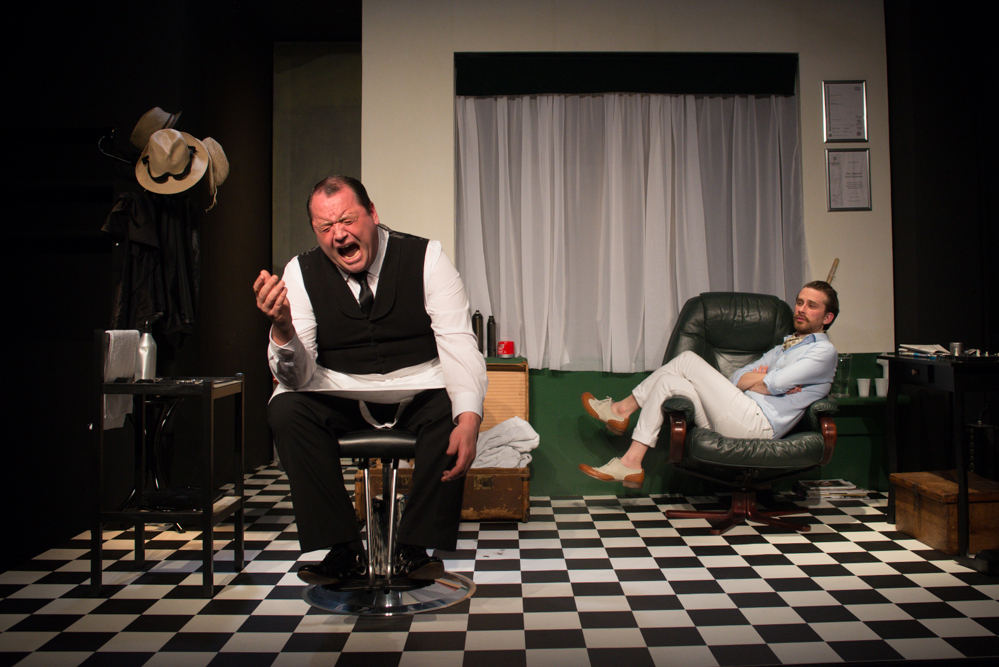
This is The Other Room’s second production, following their inaugural Blasted. The set is structurally the same. Where the ill-fortuned painting was, there now exists the similarly fated window of our barbershop where The Dying of Today unfolds.
There are further parallels. As in Blasted, we the audience are privy to a private narrative while the world outside begins to fall apart, soon to spill into the room.
Now, the catastrophe is the collapse of the Athenian empire. After a short-lived period of peace with the Peloponnesian League led by Sparta, the great naval power threw everything at Syracuse in Sicily. Defeat followed defeat which followed defeat, and few returned to tell the tale.
Supposedly a foreigner, while being shaved, spilt the disastrous beans to the barber. This play is that rumour. The British playwright Howard Barker, while revered abroad, remains largely unheard of in the UK, despite having a biblically proportioned oeuvre.
I thank The Other Room for my first foray behind Barker lines. The set design really is quite brilliant. The shop’s mirror is hung on the fourth wall; The Barber and Dneister often stare out at fixed points in the audience who are effectively on the dark side of a one-way mirror. The black and white chequered floor is a perfect enlargement of the chessboard sat in the corner: one which the two characters play their sometimes methodical, occasionally vociferous war of attrition upon. A small detail, I love the two certificates hung on the wall: the medical, surgical connotations are apt.
Both actors give strong, engaging performances. Christian Patterson, who played the unappealing Ian in the aforementioned Blasted, now dons the white barber’s apron. There remains a dangerous streak of caprice. He is powerful, both vocally and physically. He is also very big. Leander Deeny contrasts this perhaps, but is no less a presence. Sprightly and playful, he is incredibly endearing even while revealing doom and gloom. His vulnerability excites. Interesting fact: Deeny was beefy Chris Evans’ skinny body double in Captain America: The First Avenger.
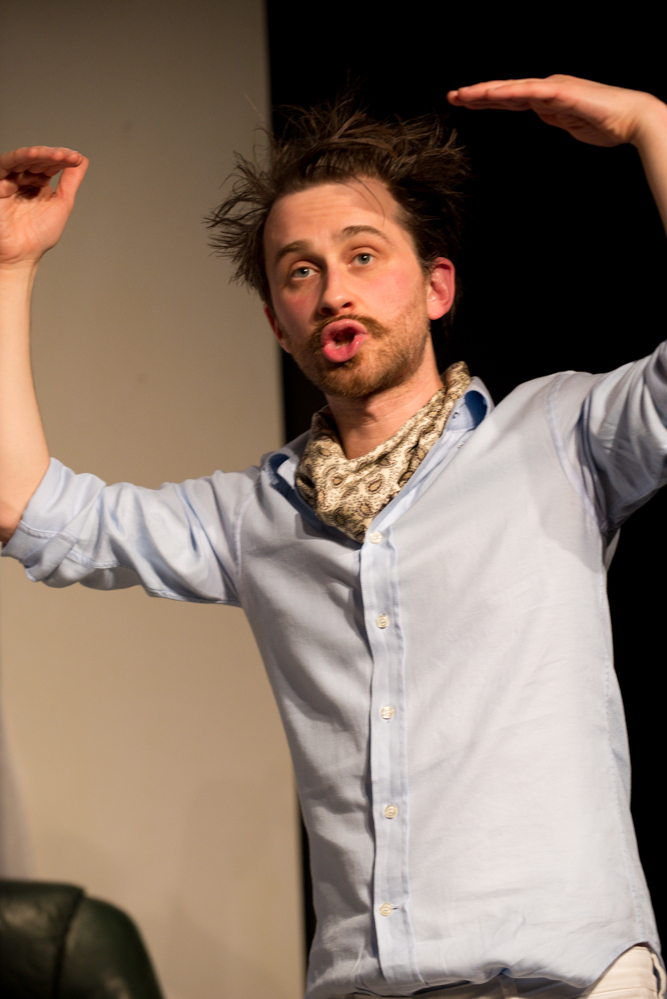
Their real performances however, shine through in their relationship with each other. On reflection it is difficult to extricate the two individuals from what is a very well performed two-hander.
Director Kate Wasserberg has really tightened the grip on Barker’s words. I have yet to look up half the ones I scrawled down on my programme in confusion. Fortunately this vocab-fest in her capable hands is not as daunting as it could be. The comic timing is delectable.
I am still unsure about the play. Initially I felt it was simply a cynical exploration of human nature. I realise it is not so simple. Again, like Blasted, it is draped in despair, making it difficult to see the good. It becomes apparent who the real victim is, good does prevail; and I like that. I agree with Natasha Tripney who, writing for The Stage, commented “the play as a whole lacks emotional weight and feels distant, surface-skimming”. I struggled to connect with either character; I didn’t pity The Barber’s personal loss as he so readily contextualises it. Disaster makes a philosopher of him. Perhaps, like Brecht’s Epic Theatre, we are encouraged to think about the state of things. I’m just not sure what that is.
You can read Dominic Cavendish’s review of its initial production at The Arcola here www.telegraph.co.uk/culture/theatre/drama/3562856/The-Dying-of-Today-at-the-Arcola-review.html
On until April 11th, I am excited by this second, successful production at The Other Room. It is close, intimate theatre: where the sounds of the bar to the left and the bins on the right remind you of the city.
Don’t miss out- tickets are available from their website www.otherroomtheatre.com
Review by Eifion Ap Cadno
Photography by Pallasca Photography
Review The Dying of Today The Other Room By Rebecca Hobbs
Much like an enthralling cinema experience when you consequently fail to reach the bottom of your popcorn, when a production at The Other Room comes to a close and you still have half a pint left, it is a sure sign that the performance has won you over. Set in a barber’s shop in just one act with two actors, the second production in the ‘Life in Close Up’ season is every bit as challenging as Sarah Kane’s brutal ‘Blasted’.

Leander Deeny and Christian Patterson
Credit: Pallasca photography
Specifically inspired by Thucydides’s account of the destruction of the Sicilian expedition during the Peloponnesian War when the navy and the Athenian army suffers a merciless and colossal defeat, Howard Barker’s The Dying of Today is an unfettered examination of that anxiety induced moment of inevitability, considering the worst case scenario and discovering how we are meant to process the phenomenon that is ‘bad news’.
Director Kate Wasserberg’s attention to detail is meticulous; the elegant transactions between the two characters allow both the bearer and hearer to feed off one another’s energy. Once again, she shatters the fourth wall and this time the audience becomes the mirror. We are the onlookers of this intimate moment, fittingly captivated in anticipation of the bad news ourselves and whilst this relates to an historical event, the scenario is timeless. Is it not reminiscent of how we respond to the sensationalist media of today? Even as a child I remember the moment that the 9/11 news hit and I can picture what I was doing and how the news was delivered of the London Bombings by the school librarian in an English lesson.
Dressed for a holiday with a touch of Hollywood glamour, the lonely traveller Leander Deeny as the bearer of bad news is quirky and charismatic. In his opening speech he wittingly and superficially luxuriates in the imminent moment of revealing the earth-shattering broadcast. The pleasure that the bearer gets as he revels in his artistry or in this case, the barber’s emotionally charged telling is both comical and curiously unsettling. As the revelation is played out, Christian Patterson demonstrates his versatility as an actor. Far from the grossly abhorrent character in Blasted, the barber’s experimentation with grief and revelation is incredibly intuitive and calls out for sympathy. The outbursts of overwhelming sorrow and emotionally charged rage were chilling yet the barber maintains dignity and has a tenderness that even manages to reach the most misunderstood bearer as fleeting moments of compassion break through his cold exterior.
In the final five minutes as the resigned barber returns his dismantled shop to the picture of normality, the artistry is at its best. The amalgamation of music and the symbolic play on the chess board set is profoundly moving and perfectly sums up Barker’s tragic poetry.
Review Man To Man Weston Studio, WMC by Barbara Michaels
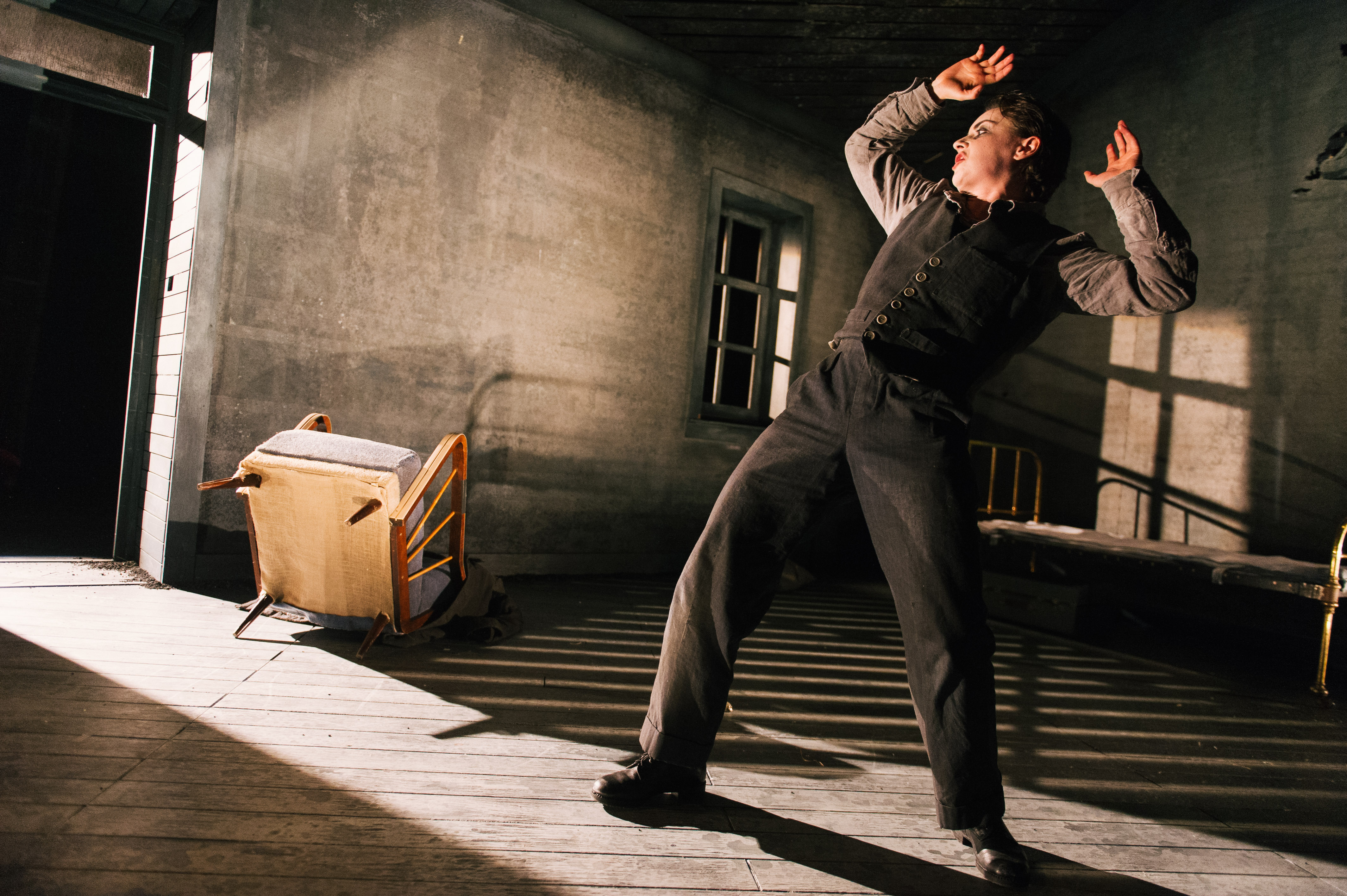
MAN TO MAN Weston Studio, Wales Millennium Centre
Book by Manfred Karge
Translated and adapted for the stage by Alexandra Wood
Co-directors Bruce Guthrie and Scott Graham
Reviewer: Barbara Michaels
Rating: [4.00]
Writer Manfred Karge has brought a new perspective to the horrors of life in Nazi Germany for those hunted down by the regime, with many forced to take extreme measures in order to survive. This is the story of Ella Gericke, a young woman who takes on her dead husband’s job as a crane driver, together with his identity, in order to live. We witness her terror and the lengths she must go to in order not to be found out. Incredibly, she manages to maintain the deception for over forty years. At the core of the piece as the reason for Ella’s decision – Hitler’s persecution of the Jews, brought to the fore when Ella is forced to eat pork (forbidden by Jewish dietary laws) in order to avoid discovery.
This is a brand-new adaptation and production of an extraordinary one-woman play that premiered back in the 1980s when it won considerable acclaim. Offering as it does a searching and searing overview of Germany under the Third Reich, this rare cross-genre piece is not to be missed not only for this reason but for its exploration of identity through episodic scenes in Ella’s life.
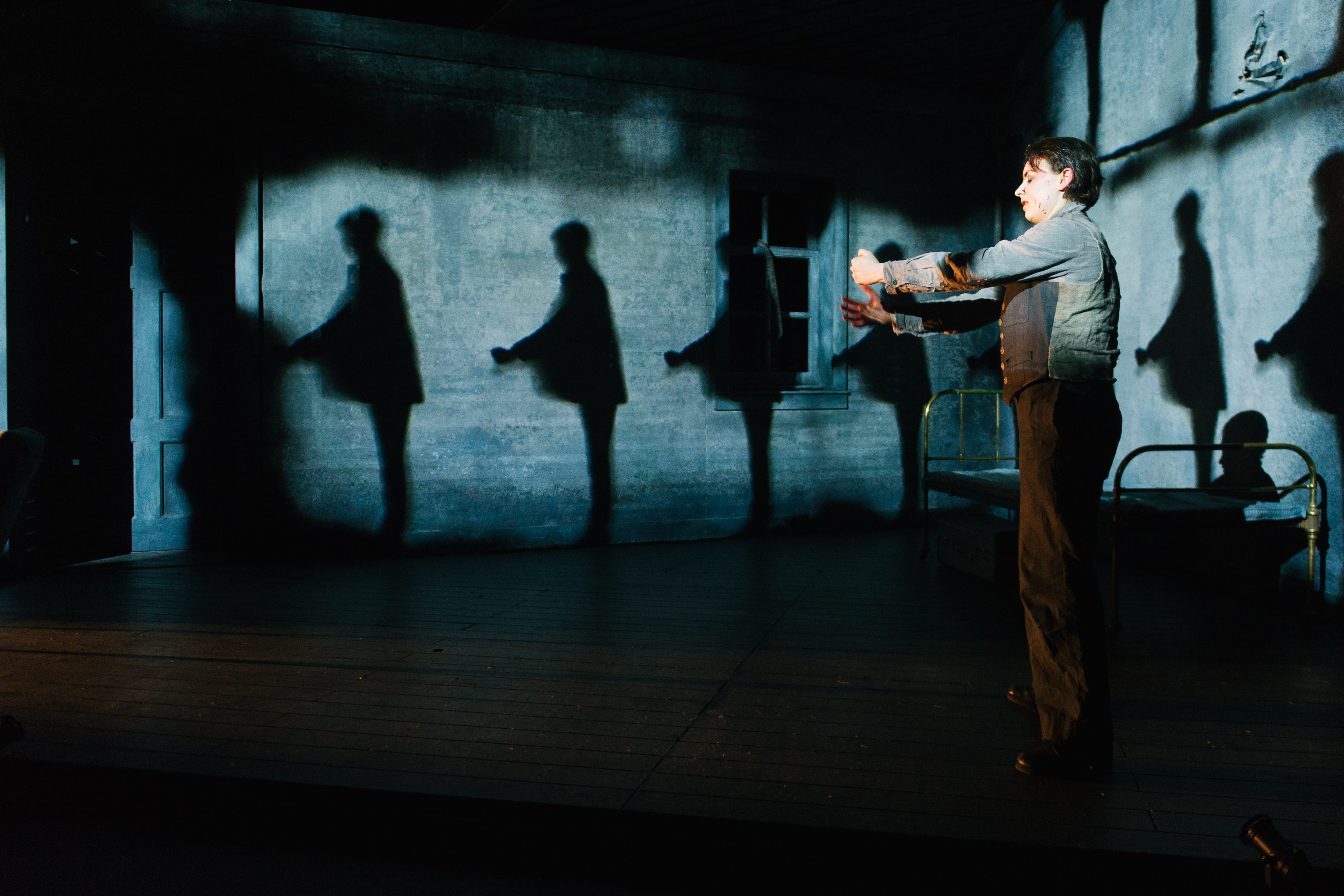
Ella, played by Margaret Ann Bain, struggles to keep afloat in a bewildering male world of beer cellars and crude masculine humour, at the same time leading a false existence with the fear of discovery looming over her. Bain manages to pull off a balancing act, maintaining credibility as a man while retaining an underlying hint of a feminine sexuality at the core of Ella’s being and making the audience aware at all times of the loneliness of a life devoid of close contact with another human being – a life dependant on its memories. No mean feat, this, and coupled with her acrobatic skills – the physicality of the role requires some difficult and hair-raising moves – lifts Bain’s performance beyond the norm, placing her next in line to Tilda Swinton, who received rave reviews for playing the role when the play was premiered at the Segauspeilhaus Bocehum under its original title of Jacke wie Hose. A small caveat, and one that is easily rectified, is that Bain could slow down a tad in the opening sequences in which a strong accent makes for a lack of clarity at times. Nevertheless, an outstanding performance by a young up and coming performer and one well worth seeing.
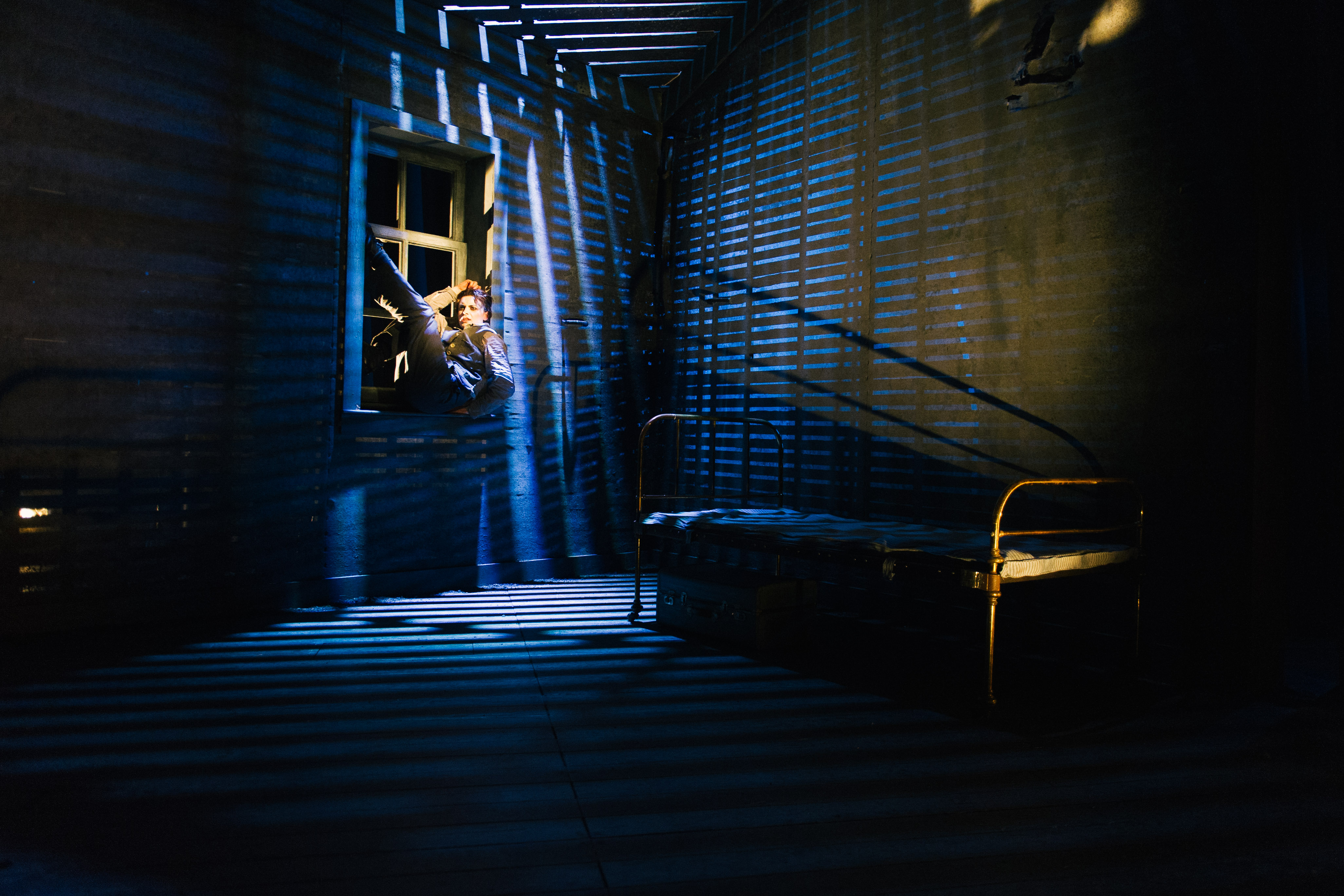
Sparsely furnished it may be, but the set by Richard Kent makes a major contribution in its depiction of scenes such as the fall of the Berlin Wall – great input by video designer Andrzej Goulding -and, poignantly, the mirror image of Ella as a girl, as does Rick Fisher’s clever lighting.
Co-directors Bruce Guthrie and Scott Graham are to be congratulated on bringing to the stage an extraordinary piece whose daring combination of prose and poetry, realism and imagination is in itself a considerable achievement.
Runs until March 27th
Photographic Credit Polly Thomas
Review Dirty Dancing Wales Millennium Centre by Bethan Hooton
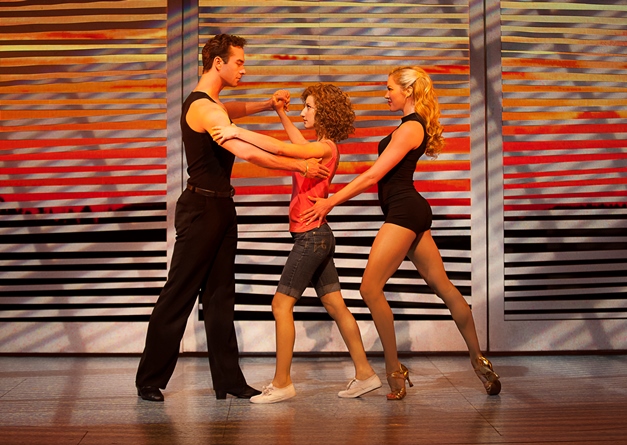
On the 19th of March I had the pleasure of going to watch Dirty Dancing live on stage at the Wales Millennium Centre, Cardiff. Dirty Dancing is set in the summer of 1963 and follows Baby (played by Roseanna Frascona) who adores her father (James Coombes) and wants to eventually join President Kennedy’s Peace Corps. Whilst on holiday with her family at Kellermans meets Johnny Castle (Gareth Bailey) a dance instructor. Instantly she’s attracted, however she annoys him but when Baby takes a risk to help out one of his friends Penny (Claire Rogers) a powerful and sexy romance begins.
First thoughts: What an amazing show! I came out of the theatre with my mind racing from the brilliance of it all. All I wanted to do was talk about everything I loved about the show.
The set: The set was designed by Stephen Brimson Lewis and I must say the way the set was presented on stage was great. I loved how everything was set up, and how the scenes transitioned. The set was simplistic so you didn’t have trouble deciding where to look but it also gave the feel of a busy holiday resort. I loved the projections of scenes at the back to help pull you into the scene and help you visualise it better. I particularly liked the use of the projections when Baby and Johnny were practicing the oh-so-famous lift. With the projections it made it look like they were in a forest, in a field full of grass and in water.
Dancing: With Dirty Dancing being a musical about dancing I obviously expected the dancing to be immense and I was not let down. It was incredible, I was mesmerised the whole time they were dancing – and considering that the musical consists mostly of dancing, that was a long time! All the dancers were in sync when they needed to be and the dances just flowed. You could really tell that the actors loved what they were doing – like dancing was just second nature to them.
Acting: One thing that really stuck with me about the show was Roseanna Frasconas acting – she’s a dancer, pretending to be a girl who doesn’t really know how to dance. I can only begin to imagine how hard that must have been. When I know how to do something I want to show it off!
The other actors were remarkable as well. Each and every one of them stayed in character the whole way though whether they had any lines or not. Also hats off to Claire Rogers who sure knows how to dance! I really liked watching the background characters during the show because they just seemed to add to the story even though they weren’t directly involved in Baby and Johnny’s romance.
Lighting: I don’t really have much to say on the lighting except that it was used perfectly. I loved the use of the Disco Balls during (I’ve Had) the Time of My Life and the way they used spotlights during some of the busier scenes – it really helped you know where you were supposed to be focusing.
Overall: Dirty Dancing was sexy, fascinating and wildly amusing. Fans of the film will not be let down, and will probably fall in love with it more! I would recommend everyone to go watch it, it truly is amazing. If I had the chance I would see it again in a heartbeat. Have you guessed, I loved it!
Oh, and just remember “Nobody puts Baby in the corner!”
Review Everyman Measure for Measure ‘perfect platform to showcase our local talent’ by Rebecca Hobbs
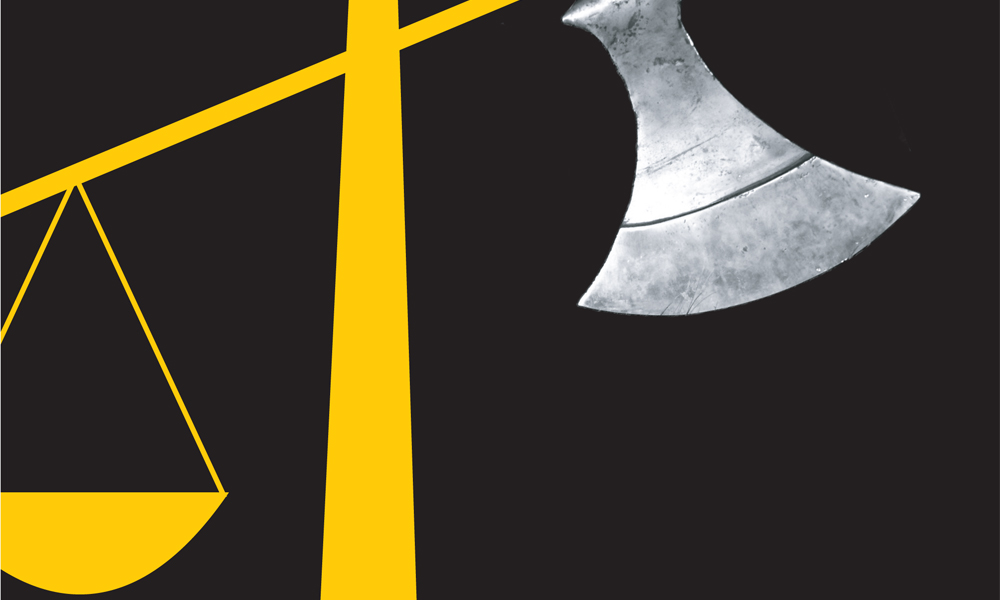
‘And now I give my sensual race the rein: Fit thy consent to my sharp appetite’
(Measure for Measure, Act II.iv.)
Set in vice riddled Vienna in the dirty suburbs where the city folk latch onto carnal desires, Measure for Measure is a work of debauchery, hypocrisy and deceit. Rising from the gutters, the Everyman Theatre’s traditional retelling is a thoroughly enjoyable and well interpreted Shakespearean rendition. As part of the Royal Shakespeare Company’s Open Stages programme, Cardiff’s Everyman Theatre has had the opportunity to work with professionals from the company and this insight is distinctively present in the performance. The leading actors and actresses demonstrate a clear understanding of the complex issues that arise in this unsettling comedy.
Reduced to a simple and understated set and a series of brief early modern musical interludes, this stripped down traditional interpretation purely relies on acting ability to carry it and the cast do a commendable job. The bawdy brothel scenes are vigorously entertaining and could have been given slightly more stage time. The low lighting in the brothel and prison scenes adds to the dingy squalor but in court, I found the lighting to be severe at times and slightly off putting.
In the play’s contrasting moments of comedic vulgarity and abhorrence, the Duke’s air of pomposity and trickery is suitably inflated by Brian Smith and the moronic Elbow, skin crawling Lucio and cheeky chappie Pompey (Arnold Phillips, Philip Jones and Dan Burrows) bring the light-hearted scenes to life. Aroused by prohibition, Angelo’s (Andreas Constantinou) moral recklessness and coldness adds a sinister edge to the production. In particular, in Act IV when he attacks Isabella (Carey Barley) in a frenzy of erotic desire, as the scene progresses, the duo’s acting is at its best. Barley’s performance is particularly professional.
When all the cast appear on stage for the final scene, there is a strong sense of camaraderie and the company’s love of performing really shines through. This group of passionate and talented individuals tackle Shakespeare’s work admirably. Chapter Arts Centre is the perfect platform to showcase our local talent.
An interview with the Blasted Cast and Director by Eifion Ap Cadno
As promised here’s my interview with The Other Room Artistic Director and Blasted director Kate Wasserberg and Blasted cast members, actors Christian Patterson (Ian), Louise Collins (Cate) and Simon Nehan (Soldier).
Why Blasted?
Kate: It’s two things really. I wanted to open The Other Room with a play that really used the intensity of the space, where being so close felt dangerous and exciting. And I wanted to interrogate our relationship with foreign wars. I find it very hard to watch the news since having my two children. It’s as if the distance between my life and those events has collapsed. And that’s what Blasted does – it collapses the distance. That seems to me to be a very humane thing to do, despite the violent things that happen in the play.
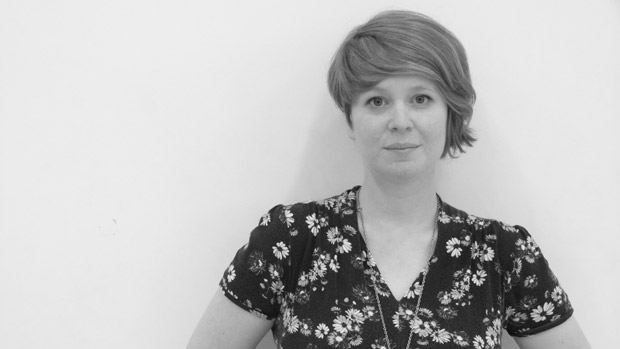
Artistic Director of the Other Room and director of Blasted Kate Wasserberg
Why do you think audiences still need to see this play?
Simon: It’s still relevant because of the base human actions in the play. It strips humans down to being animals I think. Acts of aggression and sexual encounters in the animal kingdom just happen, often without consent, which is what happens in the play. It’s a hard watch because people refuse to believe we have these instincts and are capable of these actions. Some of us are. The real drama of the play comes from the human guilt of these actions and a kindness to look beyond them.

Simon Nehan (Soldier)
Christian: It’s a game changer. In the same way as John Osborne’s Look Back in Anger changed the face of theatre in the fifties, Sarah Kane did the same thing in the nineties with Blasted. The play is twenty years old but still reads like a new play… that is very rare. I think audiences should see plays like Blasted because it evokes, provokes and demands a response. You may love it, you may hate it, but you’ll definitely have an opinion and a reason why.
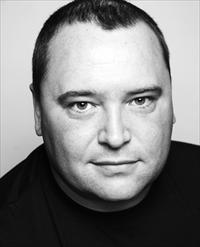
Christian Patterson (Ian)
Louise: My line “looks like there is a war on” for me is when I feel war inside. I have been violated and so my view on the world has been too. If we carry on abusing each other on a personal level then we will always be at war.
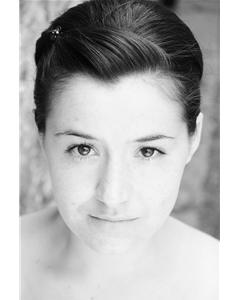
Louise Collins (Cate)
What were your thoughts before rehearsals?
Christian: When Kate offered the part to me I bought the script and read it for the first time. If I’m honest I couldn’t believe what I was reading. I laughed out loud, I was very moved, but above all I was deeply shocked. I couldn’t stop reading… and it was for that reason I decided to accept the part. I knew it was going to be challenging but ultimately I hoped it would be rewarding… and it most certainly was.
Louise: I was thrilled. I knew what an honour it was to be in The Other Room’s opening production. Fear equalled that thrill as this phenomenal play demands facing the bleakness and darkness of humanity which in my day to day life I try to avoid.
Simon: My first thought was how are we going to stage it? How graphic are we going to be? There are so many technical parts to the play and we only had three weeks to pull it off.
What’s it been like working with the cast?
Kate: They are all actors I have worked with before but never all together. They are amazing. To do this play for real, to go out there every night and really be in that place and never fake it – that is an extremely rare and astonishing thing. Plus they are all very funny and generous people so it was lovely to work with them.
What’s it been like working with director Kate Wasserberg?
Louise: I am so grateful Kate gave me the opportunity to play Cate. I’m lucky. The acting industry can be full of ego and profile but she sees things in me I don’t even know are possible and that’s the beautiful relationship between an actor and director.
Simon: I’ve worked with Kate before this project in Clwyd Theatr Cymru. Kate is a real actors’ director. She leaves you to put it on its feet and nudges or pulls you (if needed) in the right direction. You really feel like you have an input into the process and that it’s a collaboration.
Christian: This was my fourth play with Kate. I don’t think I could do for others what I can do for Kate. She never casts me in an obvious part…most directors wouldn’t consider me for Roma in Glengarry Glen Ross, Casimir in Aristocrats, and certainly not as Ian in Blasted. She really challenges me. When the phone rings and it’s a job offer from Kate I know to strap myself in and trust her implicitly.
How do you think set, lighting and sound have shaped this production?
Kate: We were incredibly lucky with the team. Max Jones and Ruth Hall designed the set and it’s an extraordinary achievement in that space – a design that reveals itself as the play goes on and is a character in its own right. Tom White’s lighting is bold and beautiful and Dyfan Jones did fantastic work on the sound design. The composer and playwright Nick Gill wrote an album in response to Blasted especially for us, which we used throughout. The tender and poetic view the music takes of the play had a huge effect on me and I really tried to find that tenderness in the scenes.
The Other Room is a small venue; with only forty-four seats what challenges has it posed?
Kate: It’s forty-seven actually! The seats were the last thing to go in so we didn’t know until the last-minute exactly what the capacity might be and were pleasantly surprised. The challenges are generally more about budget than space – obviously with such a small house ticket sales don’t add up to very much. The biggest impact was only having three weeks rather than four to rehearse. It meant we opened the show very raw, very early. That was terrifying. But we pulled it off I think.
Simon: It’s wonderful to play such an intimate space particularly with this play because it’s so in your face. You can see the whites of our eyes, but we can see the whites of yours. Every uncomfortable shuffle in a chair, hands over eyes or mouths, or groans we see and hear. Makes for an interactive experience.
Christian: I love being close to an audience in the same way I love being close to the actors as an audience member. When you perform in two thousand seater theatres like Drury Lane you need to be more expansive to ensure every audience member is getting near enough the same experience. But when you are up close and personal I try to connect with the other person on stage more and leave the connection take care of itself. It’s very similar to acting for camera.
Louise: It’s intense just like the play, and requires you to be totally committed and connected. That’s why it’s perfect Blasted has opened The Other Room.
Can you tell me the toughest moment of this process?
Louise: Coming in carrying the baby from the war zone… I did a lot of research to get myself to a place of truth. I find it incredibly difficult to take on the news and what’s really happening out there.
Simon: For me it wasn’t a moment, it was the whole rehearsal process. It’s a hard play. Not just in its staging but actually doing the characters justice. It would be so easy just to play how nasty and cruel these characters are. You have to find out why and how they behave this way. It doesn’t matter how evil your character is – finding that one percent of good in them is what gives them depth. Trying to discover this was my toughest challenge in rehearsals.
Christian: Learning to trust the changes in location in relation to where you and the other characters are. It was quite difficult to find a through line so I stopped trying to find one. Instead I played each scene as a play and started again in the next as if the previous one never happened. That worked for me. It’s like watching an illusionist… I know it’s not real but I don’t need to know how it’s done. It was all about submitting to each scene for me.
How do you feel coming out the other end of this production?
Christian: This is a weird one. After the first preview Simon and I sat in the theatre for nearly forty-five minutes. I just couldn’t move. I felt teary. I felt nervous. I felt surges of adrenalin coursing through me. I was exhausted. I thought what are people going to make of this?
Simon: We were too apprehensive to go into the bar to see people’s reactions.
Christian: Most of the time you have some sort of idea how a production will be received but with Blasted I had no idea whatsoever. I learned to embrace feeling slightly weird after the play. Now the run has ended I feel bereft. It has changed me as an actor and as a person. It made me feel brave and I will always cherish that.
Simon: It gets easier the more you do it. You try to go through the mill in the rehearsal room so that by the time you get on stage you can switch it on but more importantly when it’s finished to switch it off. You can’t take this play out of the room with you.
Louise: Everything has to end, but I will be very sad to say goodbye to my character Cate. She carries such hope and sees the positive. I will miss The Other Room too. Every now and then you have a gem of a job that stays with you for life.
Your next production, Howard Barker’s The Dying Of Today, will open at The Other Room on March 24th and is already in rehearsals; what can prospective audiences expect?
Kate: It’s a funny and moving play, about a very odd but (I think) very true idea – that we are compelled to share bad news when we hear it; and that on some level huge tragedy thrills and excites us in a way that joy never can. Christian Patterson plays a barber who has this stranger (played by Leander Deeny) come into his shop and announce he has The Worst News Ever. That’s the starting point. I love Howard Barker’s writing, it is unashamedly clever but there is deep passion there too. We are having a really good time working on it.
What do you think The Other Room has to offer?
Louise: Honest, creative and thrilling work.
Christian: There is no other space like it in all of Wales. It will provide high end theatre for years to come. For me, being a part of the inaugural season is a genuine privilege. In years to come I will still be saying “I did the very first production there”. That means the world to me.
Simon: The Other Room is the most exciting project that has happened in Welsh theatre for years. Cardiff has been crying out for a theatre like this. There is nowhere you will see a more intimate performance. The team behind the project are amazing and Porter’s bar is the perfect venue for it. I look forward to supporting them and hopefully working them again.
Kate: I hope The Other Room offers a great night out. We aim to make world-class theatre in our little space, and we are in a really cool bar so you can take your drink in! The work is bold and modern, and so far audience responses have been amazing. It’s been an incredible opening, and I really hope we continue to grow and to welcome more people to share our work. Thank you!
Article by Eifion Ap Cadno
Blasted a return visit and second time thoughts by Eifion Ap Cadno
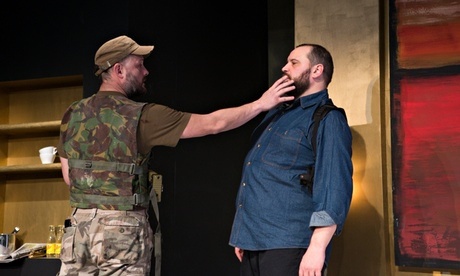
Production photo by Pallasca Photography
Those who saw The Other Room’s production of Sarah Kane’s Blasted might not understand this:
I saw it twice.
You can read my initial review here https://theyoungcritics.wordpress.com/2015/02/21/review-of-the-other-rooms-production-of-sarah-kanes-blasted/
Invited to see it again, I’m tasked with talking about its development. I’m currently reading Pat Barker’s Regeneration which explores our ability to squirrel away traumatic and unpleasant experiences to a store of bad nuts never to be touched again. Could this be a bad nut?
Last time I sat in the back row. This time, the second, almost the same level as the cast. This alone gives me a very different perspective. The white curtains along the right wall remind me of the fatal veil in Harry Potter, which you only pass through once. Thankfully there wasn’t a fire, as these curtains cover the fire escape.
There are more voices in composer Nick Gill’s soundtrack. I wonder if this is true; if I’m noticing more; or if I’ve finally cracked.
Ian’s first line “I’ve shat in better places than this” elicits no laughter. Of course, between two shows there are many subtle differences in the delivery of lines and their reception. But for one of my most intimate theatrical experiences to date, I held Ian’s terrified gaze as he was raped by the Soldier. I felt helpless, but comforted myself with “It’s only theatre!”
A reminder of this came after the blast. A spotlight blinds the audience, masking the back-wall as it falls away, revealing a great big hole strewn with tattered painting and remnants of the bathroom behind. There is silence. Smoke fills the room. Considering The Other Room is the size of a moderate lounge, they tackled this coup de theatre with gusto. However, just before I get too carried away, someone – in full view – carries a large rectangular piece of set out the back. If anything, this is endearing. A small breath before being plunged back into the cold depths of Kane.
While the set is adjusted – an unwritten scene played out in the shadows – Nick Gill’s soundscape takes over again. With more rainwater than I recall, I nod along and smile. This is beautiful! I almost don’t want the lights to rise.
This is the difference in my viewings. The first was a blanket experience. I was smothered in dread, violence and occasionally pricked with a rogue duck feather of hope. This time, everything is a little clearer and more distinct.
Perhaps this is helped by the audience. Previously, I sat amongst other critics and The Other Room associates who presumably had some idea of what was in store (a bad nut). Now, I can see my own expression reflected, heightened in the gurns of others; hands cover eyes and mouths; a woman retches beside me. Soon, she is uncontrollably sobbing. She thanks her friend for comforting her while on stage a desperate Ian thanks Cate – what symmetry!
The show also appears to have taken its toll on the actors. At the end Ian is shown in various acts of depravity and degradation. Between these, I watch actor Christian Patterson pick himself up in the darkness, and move into position for the next. He looks to have aged.
The cast have since pinned down even more nuances in the text. I made further connections and felt the subtext breathing down my neck. It was the first show I have initiated applause at: I wanted to free the actors.
Shortly after, those in the audience who haven’t wandered off into the night are invited for a post-show talk with the aforementioned Simon Kane. I imagined him to be sharp-featured and brooding. Not quite what I was expecting, he reminded me of an old school friend. After Blasted, he had me chortling at his casual description of “Ian ‘avin’ a shit, Ian ‘avin’ a nightmare, Ian eatin’ a baby”.
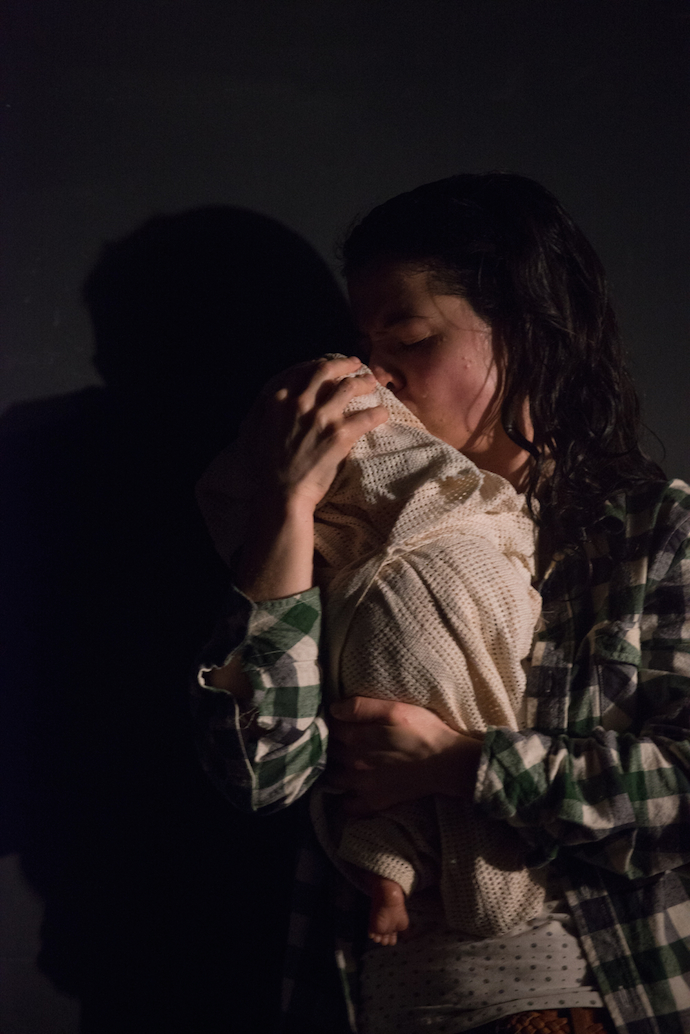
As manager of her estate, it sounds like Simon was initially quite protective over his dead sister’s plays, allowing few companies to take them on. For those he did, he monitored their directorial choices, ensuring “daft decisions like making the Soldier a woman” didn’t happen – I wish I’d asked why he thought that specifically –; often taking an active part in rehearsals. However, as time’s progressed he has relaxed. He realises “they’re plays, not novels. They’ll go through different filters”.
Mentioning Daily Mail theatre critic Jack Tinker’s comment that Blasted is a “disgusting piece of filth”, Helen Perry, Radio Drama Producer at the BBC, asks “How do you explore horrible themes without showing horrible things? Does that make sense?”
Simon replies with a short “No. I don’t know what to say”. However, he soon fires up with another film allusion: he mentions Quentin Tarantino’s films. In Reservoir Dogs “there’s cool music as someone’s having their ear cut off but Blasted doesn’t glamorise violence.”
He talks about their family’s reaction to Sarah Kane’s plays. Their father, a journalist for the Daily Mirror who’s “not far from Ian in some ways”, didn’t like Blasted until it was slated. Their mother can’t reconcile herself with it. They don’t see it any more.
Most interestingly he relates how their granddad, who served in the war, approached Sarah and said “I know how these things have happened. I’m worried how you do”.
Simon says (I couldn’t run from that forever) “She doesn’t make this stuff up”.
Read more about Sarah Kane, Blasted and its inspiration in this article written by playwrights Simon Stephens and Laura Wade http://www.theguardian.com/stage/2010/oct/24/sarah-kane-blasted
Now The Other Room’s first production has ended, roll on the next: Howard Barker’s The Dying of Today will be on 24th March – 11th April. Another British playwright, his plays are acclaimed and produced extensively abroad but have received little recognition here on home turf. Evidently this little theatre wants to produce plays that are in some way unexpected.
More information and tickets for productions can be found on their website http://www.otherroomtheatre.com/en/
